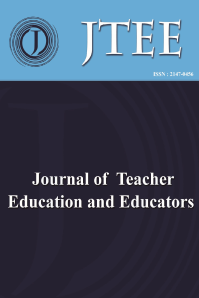Öğretmenin Kendini Açması Uygunluğu Konusunda Öğretmen Algıları: Türkiye’den Bir Durum Çalışması Fidel Çakmak1 ve Betül Arap2
Bu çalışmanın amacı Türkiye bağlamında “öğretmenin kendini açması” nın (ÖKA) uygunluğuna ilişkin, hizmetteki öğretmenlerin ve öğretmen adaylarının algılarını araştırmaktır. Zhang, Shi, Tonelson ve Robinson (2009) tarafından yapılan çalışmanın uyarlaması olan bu çalışma Türkiye’de hizmette olan öğretmenleri (s=60) ve hizmet öncesi öğretmen adaylarını (s=76) kapsamaktadır. Sonuçlara göre, öğretmenlerin ve öğretmen adaylarının kendilerini açmalarının uygunluğuna ilişkin algılarında iki boyutta istatistiksel açıdan önemli farklılıklar bulunmaktadır: Sıradan konular ve sıra dışı konular. Diğer üç boyutta, sıra dışı amaçlar, sıradan amaçlar ve öğrencileri dikkate alma boyutlarında, iki grup öğretmen arasında istatistiksel olarak önemli farklılıklar bulunmamıştır. Her iki çalışma da öğretmenlerin kendilerini açmalarının amacı ve sıra dışı konuların uygunsuzluğuna ilişkin algılarında benzer sonuçlar sunmuştur. Öğretmenlerin kendilerini açmalarına dair sıradan konuların, sıra dışı amaçların ve öğrencileri dikkate alma uygunluğunun boyutları açısından iki çalışmada farklı sonuçlar bulunmuştur. Bu çalışma Türkiye’den bir vaka çalışması ile alana katkıda bulunmakta ve aynı zamanda öğretmenin deneyim yılının ve öğretme bağlamının ÖKA’nın uygunluğunun algısını etkileyebileceğini belirtmektedir
Anahtar Kelimeler:
öğretmenin kendisini açması, öğretmenin kendisini açması ile ilgili algılama, öğretmenin kendisini açmasının uygunluğu
Teachers’ Perceptions of the Appropriateness of Teacher Self-Disclosure: A Case Study from Turkey
Teacher self-disclosure (TSD) is regarded as a means of increasing student understanding, participation, interest, and motivation. The aim of the present paper is to investigate in-service and pre-service teachers’ perceptions of the appropriateness of teacher self-disclosure in a Turkish context. It is a replication study of that of Zhang, Shi, Tonelson,&Robinson (2009) and included pre-service teachers (n=76) and in-service teachers (n=60) from Turkey. The results indicate statistically significant differences within two groups of teachers in their perceptions of the appropriateness of teacher self-disclosure in two areas: common topics and uncommon topics. There were no statistically significant differences in three other dimensions; uncommon purposes, common purposes and consideration of students. Both studies have yielded similar results in terms of the perceptions of the purpose of teacher self-disclosure and of the inappropriateness of uncommon topics. Contrasting results were found in the appropriateness of common topics of teacher self-disclosure, uncommon purpose and consideration of students. The study contributes to the field as a furtherance of the case study with a sample from Turkey and it implies that the year of experience and teaching context might affect the perceptions of appropriateness of TSD
Keywords:
teacher self-disclosure, perception of teacher self-disclosure, appropriateness of teacher self-disclosure,
___
- Cayanus, J. L., Martin, M. M.&Weber, K. D. (2003). The relationships between teach- er self-disclosure with out-of-class communication, student interest, and cognitive learning. Paper presented at the annual meeting of the Southern States Communi- cation Association, Birmingham, AL, April.
- Cayanus, J. L.&Martin, M. M. (2004). An instructor self-disclosure scale. Communi- cation Research Reports, 21, 252-263.
- Cayanus, J. L., Goodboy, A. K.&Martin, M. M. (2009). The relation between teacher self-disclosure and student motives to communicate. Communication Research Reports, 26(2), 105-113.
- Connelly, F. M.&Clandinin, D. J. (1988). Teachers as curriculum planners: Narratives of experience. New York: Teachers College Press.
- Field, A. (2005). Discovering Statistics using SPSS. London: Sage Publications.
- Goldstein, G. S.&Benassi, V. A. (1994). The relation between teacher self-disclosure and student classroom participation. Teaching of Psychology, 21, 212-216.
- Gregory, L. D. (2005). Influence in the classroom: Exploring instructor self-disclosive
- communication and student outcomes in higher education. Unpublished doctoral dis- sertation. University of Miami, Coral Gables.
- Hartlep, K. (2001). Self-reference and instructor self-disclosure: Is gossip easier to
- remember? The Online Journal of Teaching and Learning in the CSU. Retrieved from http://www.exchangejournal.org. on 3.1. 2012.
- Jourard, S. M. (1971) Self-disclosure: The experimental investigation of the transpar- ent self. New York: Wiley.
- Lannutti, P. J.&Strauman, E. C. (2006). Classroom communication: The influence of instructor self-disclosure on student evaluations. Communication Quarterly, 54, 89-99.
- Mazer, J. P., Murphy, R. E.&Simonds, C. J. (2007). I’ll see you on Facebook: The effects of computer-mediated teacher self-disclosure on student motivation, affec- tive learning, and classroom climate. Communication Education, 56, 1-17.
- McCarthy, P. R.&Schmeck, R. R. (1982). Effects of teacher self-disclosure on student learning and perceptions of teacher. College Student Journal, 16, 45-49.
- Sorensen, G. (1989). The relationship among teachers’ self-disclosive statements, stu- dents’ perceptions, and affective learning. Communication Education, 38, 259- 276
- Taylor, D. A. (1979). Motivational bases. In G. J. Chelune (Ed.), Self-disclosure: Ori- gins, patterns, and implications of openness in interpersonal relationships (pp. 110-151). San Francisco: Jossey-Bass.
- Wambach, C.&Brothen, T. (1997). Teacher self-disclosure and student classroom par- ticipation revisited. Teaching of Psychology, 24, 262-263.
- Wheeless, L. R. (1978). A follow-up study of the relationships among trust, disclosure and interpersonal solidarity. Human Communication Research, 4, 143-157.
- Wheeless, L. R.&Grotz, J. (1976). Conceptualization and measurement of reported self-disclosure. Human Communication Research, 2, 338-346.
- Zhang, S., Shi, Q., Tonelson, S.&Allen, D. (2007). Pre-service teachers’ perceptions of appropriateness of teacher self-disclosure. Paper presented at the 5th Annual Hawaii International Conference on Education. Hawaii, Honolulu, 5-8 January.
- Zhang, S., Shi, Q., Tonelson, S.&Robinson, J. (2009). Pre-service and in-service teachers’ perceptions of appropriateness of teacher self-disclosure. Teaching and Teacher Education, 29, 1117-1124.
- ISSN: 2147-0456
- Başlangıç: 2012
- Yayıncı: İlknur GÖKÇE
Sayıdaki Diğer Makaleler
OTMG Modelinin Okul Kültürüne Etkisi (Hatay İli Örneği
Hülya YALÇINKAYA, Filiz METE, Sevinç Aksay ALBUZ
